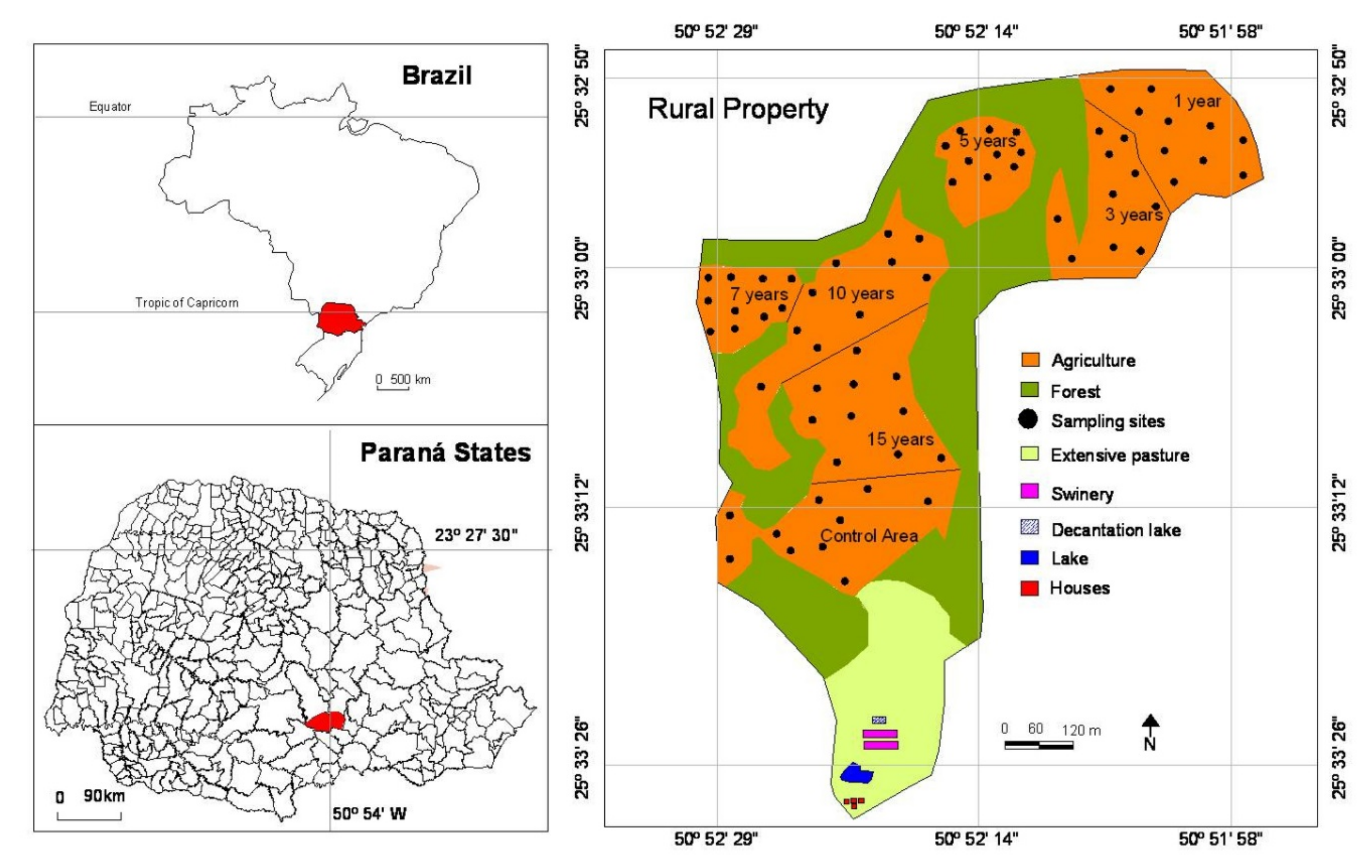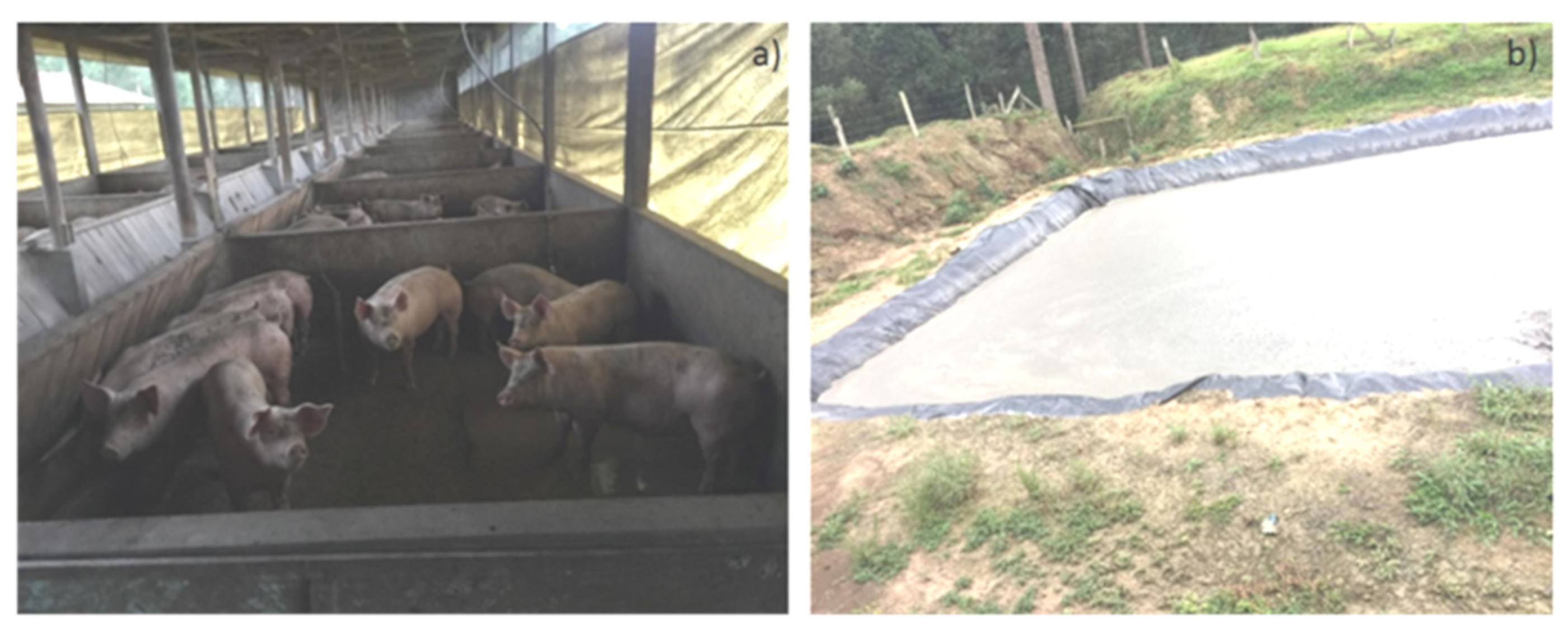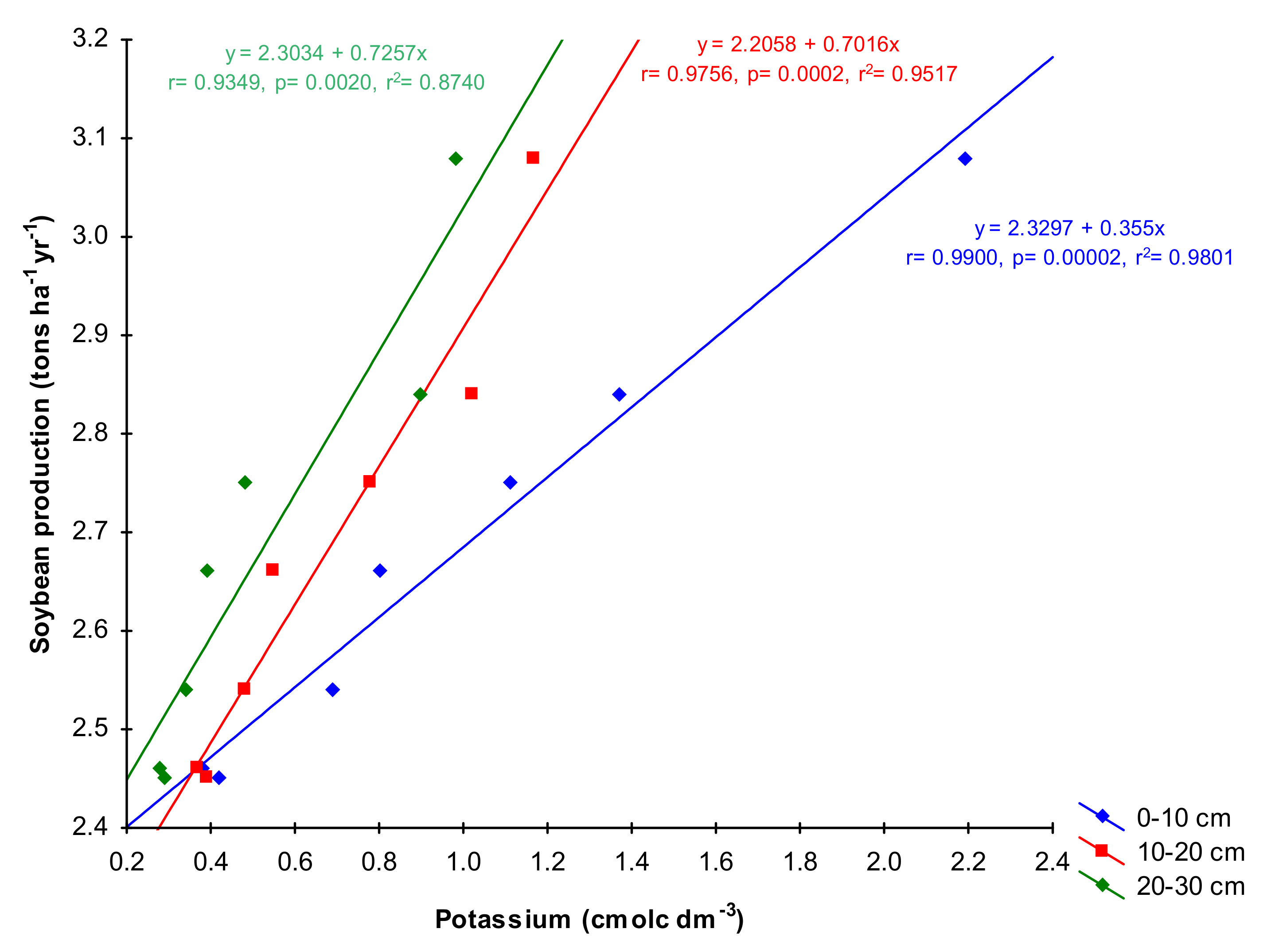Effects of Applying Liquid Swine Manure on Soil Quality and Yield Production in Tropical Soybean Crops (Paraná, Brazil)
Abstract
1. Introduction
2. Materials and Methods
2.1. Study Area
2.2. Soil Sampling and Analysis
2.3. Data Analysis
3. Results
3.1. Chemistry of Swine Manure
3.2. Soil Properties
3.3. Correlation and Regression Analysis
4. Discussion
5. Conclusions
Author Contributions
Funding
Acknowledgments
Conflicts of Interest
References
- Tripathi, A.D.; Mishra, R.; Maurya, K.K.; Singh, R.B.; Wilson, D.W. Estimates for World Population and Global Food Availability for Global Health. In The Role of Functional Food Security in Global Health; Elsevier: Amsterdam, The Netherlands, 2019; pp. 3–24. [Google Scholar]
- Godfray, H.C.J.; Beddington, J.R.; Crute, I.R.; Haddad, L.; Lawrence, D.; Muir, J.F.; Pretty, J.; Robinson, S.; Thomas, S.M.; Toulmin, C. Food security: The challenge of feeding 9 billion people. Science 2010, 327, 812–818. [Google Scholar] [CrossRef] [PubMed]
- Steinfeld, H.; Gerber, P.; Wassenaar, T.; Castel, V.; de Haan, C. Livestock’s Long Shadow: Environmental Issues and Options; Food & Agriculture Organization: Rome, Italy, 2006; p. 390. [Google Scholar]
- Stolnitz, G.J. The demographic transition: From high to low birth rates and death rates. In Population Growth; Routledge: Abingdon, UK, 2017; pp. 30–46. [Google Scholar]
- Errecart, V.; Lucero, M.; Sosa, M. Análisis del mercado mundial de carnes; Facultad de Economía y Negocios, Universidad Nacional de San Martín: Tarapoto, Perú, 2015. [Google Scholar]
- Ali, M.E.; Razzak, M.A.; Hamid, S.B.A.; Rahman, M.M.; Al Amin, M.; Rashid, N.R.A. Multiplex PCR assay for the detection of five meat species forbidden in Islamic foods. Food Chem. 2015, 177, 214–224. [Google Scholar] [CrossRef] [PubMed]
- Dugan, B. Religion and food service. Cornell Hotel Restaur. Adm. Q. 1994, 35, 80–85. [Google Scholar] [CrossRef]
- Leitzmann, C. Vegetarian nutrition: Past, present, future. Am. J. Clin. Nutr. 2014, 100, 496S–502S. [Google Scholar] [CrossRef] [PubMed]
- De Souza, H.C.; de Almeida Fehr, L.C.F.; de Souza Trindade, J.A.; Tavares, M.; Custos de produção de suínos: Estudo nos principais estados produtores do Brasil. Anais do Congresso Brasileiro de Custos-ABC. 2018. Available online: https://anaiscbc.emnuvens.com.br/anais/article/view/4476 (accessed on 17 July 2019).
- Sá, M.; Aita, C.; Doneda, A.; Pujol, S.; Cantú, R.; Jacques, I.; Bastiani, G.; Oliveira, P.; Lopes, P. Dinâmica da população de coliformes durante a compostagem automatizada de dejetos líquidos de suínos. Arq. Bras. Med. Vet. Zootec. 2014, 66, 1197–1206. [Google Scholar] [CrossRef][Green Version]
- Marinho Mathias, J.F.C. Manure as a resource: Livestock waste management from anaerobic digestion, opportunities and challenges for Brazil. Int. Food Agribus. Manag. Rev. 2014, 17, 87–110. [Google Scholar]
- Hountin, J.; Karam, A.; Couillard, D.; Cescas, M. Use of a fractionation procedure to assess the potential for P movement in a soil profile after 14 years of liquid pig manure fertilization. Agric. Ecosyst. Environ. 2000, 78, 77–84. [Google Scholar] [CrossRef]
- Scherer, E.E.; Baldissera, I.T.; Nesi, C.N. Propriedades químicas de um Latossolo Vermelho sob plantio direto e adubação com esterco de suínos. Revista Brasileira de Ciência do Solo 2007, 31, 123–131. [Google Scholar] [CrossRef]
- Mhlontlo, S.; Muchaonyerwa, P.; Mnkeni, P. Effects of sheep kraal manure on growth, dry matter yield and leaf nutrient composition of a local amaranthus accession in the central region of the Eastern Cape Province, South Africa. Water SA 2007, 33, 363–368. [Google Scholar] [CrossRef]
- Hao, X.; Chang, C. Does long-term heavy cattle manure application increase salinity of a clay loam soil in semi-arid southern Alberta? Ecosyst. Environ. 2003, 94, 89–103. [Google Scholar] [CrossRef]
- De Cesare Barbosa, G.M.; de Oliveira, J.F.; Miyazawa, M.; Ruiz, D.B.; Tavares Filho, J. Aggregation and clay dispersion of an oxisol treated with swine and poultry manures. Soil Tillage Res. 2015, 146, 279–285. [Google Scholar] [CrossRef]
- Kafle, G.K.; Chen, L. Comparison on batch anaerobic digestion of five different livestock manures and prediction of biochemical methane potential (BMP) using different statistical models. Waste Manag. 2016, 48, 492–502. [Google Scholar] [CrossRef] [PubMed]
- Szczech, M.; Smolińska, U. Comparison of suppressiveness of vermicomposts produced from animal manures and sewage sludge against Phytophthora nicotianae Breda de Haan var. nicotianae. J. Phytopathol. 2001, 149, 77–82. [Google Scholar] [CrossRef]
- Meng, L.; Ding, W.; Cai, Z. Long-term application of organic manure and nitrogen fertilizer on N2O emissions, soil quality and crop production in a sandy loam soil. Soil Biol. Biochem. 2005, 37, 2037–2045. [Google Scholar] [CrossRef]
- Qian, X.; Shen, G.; Wang, Z.; Zhang, X.; Hong, Z. Effect of swine liquid manure application in paddy field on water quality, soil fertility and crop yields. Paddy Water Environ. 2018, 16, 15–22. [Google Scholar] [CrossRef]
- Mawdsley, J.L.; Bardgett, R.D.; Merry, R.J.; Pain, B.F.; Theodorou, M.K. Pathogens in livestock waste, their potential for movement through soil and environmental pollution. Appl. Soil Ecol. 1995, 2, 1–15. [Google Scholar] [CrossRef]
- Amin, M.M.; Forslund, A.; Bui, X.T.; Juhler, R.K.; Petersen, S.O.; Lægdsmand, M. Persistence and leaching potential of microorganisms and mineral N in animal manure applied to intact soil columns. Appl. Environ. Microbiol. 2013, 79, 535–542. [Google Scholar] [CrossRef] [PubMed]
- Westerman, P.; Bicudo, J. Management considerations for organic waste use in agriculture. Bioresour. Technol. 2005, 96, 215–221. [Google Scholar] [CrossRef] [PubMed]
- Kunz, A.; Miele, M.; Steinmetz, R. Advanced swine manure treatment and utilization in Brazil. Bioresour. Technol. 2009, 100, 5485–5489. [Google Scholar] [CrossRef]
- Sigua, G.C.; Palhares, J.C.P.; Kich, J.D.; Mulinari, M.R.; Mattei, R.M.; Klein, J.B.; Muller, S.; Plieske, G. Microbiological quality assessment of watershed associated with animal-based agriculture in Santa Catarina, Brazil. Water Air Soil Pollut. 2010, 210, 307–316. [Google Scholar] [CrossRef]
- Cherubini, E.; Zanghelini, G.M.; Alvarenga, R.A.F.; Franco, D.; Soares, S.R. Life cycle assessment of swine production in Brazil: A comparison of four manure management systems. J. Clean. Prod. 2015, 87, 68–77. [Google Scholar] [CrossRef]
- Asada, K.; Yabushita, Y.; Saito, H.; Nishimura, T. Effect of long-term swine-manure application on soil hydraulic properties and heavy metal behaviour. Eur. J. Soil Sci. 2012, 63, 368–376. [Google Scholar] [CrossRef]
- Loss, A.; Lourenzi, C.R.; dos Santos Junior, E.; Junior, C.A.M.; Benedet, L.; Pereira, M.G.; de Cássia Piccolo, M.; Brunetto, G.; Lovato, P.E.; Comin, J.J. Carbon, nitrogen and natural abundance of 13C and 15N in biogenic and physicogenic aggregates in a soil with 10 years of pig manure application. Soil Tillage Res. 2017, 166, 52–58. [Google Scholar] [CrossRef]
- Andrade, A.P.; Rauber, L.P.; Mafra, Á.L.; Baretta, D.; Rosa, M.G.d.; Friederichs, A.; Mafra, M.S.H.; Casara, A.C. Changes in physical properties and organic carbon of a Kandiudox fertilized with manure. Ciência Rural 2016, 46, 809–814. [Google Scholar] [CrossRef]
- De Melo, T.R.; Pereira, M.G.; de Cesare Barbosa, G.M.; da Silva Neto, E.C.; Andrello, A.C.; Tavares Filho, J. Biogenic aggregation intensifies soil improvement caused by manures. Soil Tillage Res. 2019, 190, 186–193. [Google Scholar] [CrossRef]
- IUSS Working Group WRB. World Reference Base for Soil Resources 2014, Update 2015. International Soil Classification System for Naming Soils and Creating Legends for Soil Maps; World Soil Resources Reports No. 106; FAO: Rome, Italy, 2015; p. 203. [Google Scholar]
- Yoder, R.E. A direct method of aggregate analysis of soils, and a study of the physical nature of erosion losses. J. Am. Soc. Agron. 1936, 28, 337–351. [Google Scholar] [CrossRef]
- Kiehl, E. Manual de edafologia: Relação solo-planta; Ceres: Piracicaba, Brazil, 1979; p. 262. [Google Scholar]
- Kemper, W.D. Aggregate stability. In Methods of Soil Analysis; Black, C.A., Ed.; American Society of Agronomy: Madison, WI, USA, 1965; pp. 499–510. [Google Scholar]
- Coile, T.S. Soil samplers. Soil Sci. 1936, 42, 139–142. [Google Scholar] [CrossRef]
- Donagema, G.K.; de Campos, D.B.; Calderano, S.B.; Teixeira, W.; Viana, J.M. Manual de métodos de análise de solo. In Embrapa Solos-Documentos (INFOTECA-E); EMBRAPA: Brasilia, Brazil, 2011. [Google Scholar]
- MAPA. Métodos oficiales de análisis: Suelos y aguas; Ministerio de Agricultura, Pesca y Alimentación, Dirección General de Politica Alimentaria: Madrid, Spain, 1982; p. 182. [Google Scholar]
- Walkley, A.; Black, L.A. An examination of Degtjareff method for determining soil organic matter and a proposed modification of the chromic acid titration method. Soil Sci. 1934, 37, 29–38. [Google Scholar] [CrossRef]
- Statsoft. STATISTICA (Data Analysis Software System), Version 6; Statsoft: Tulsa, OK, USA, 2001. [Google Scholar]
- Antoneli, V.; Rebinski, E.; Bednarz, J.; Rodrigo-Comino, J.; Keesstra, S.; Cerdà, A.; Pulido Fernández, M. Soil erosion induced by the introduction of new pasture species in a faxinal farm of southern Brazil. Geosciences 2018, 8, 166. [Google Scholar] [CrossRef]
- Rout, G.; Samantaray, S.; Das, P. Aluminium toxicity in plants: A review. Agronomie 2001, 21, 3–21. [Google Scholar] [CrossRef]
- Zech, W.; Senesi, N.; Guggenberger, G.; Kaiser, K.; Lehmann, J.; Miano, T.M.; Miltner, A.; Schroth, G. Factors controlling humification and mineralization of soil organic matter in the tropics. Geoderma 1997, 79, 117–161. [Google Scholar] [CrossRef]
- Chang, C.; Janzen, H. Long-term fate of nitrogen from annual feedlot manure applications. J. Environ. Qual. 1996, 25, 785–790. [Google Scholar] [CrossRef]
- Mellek, J.E.; Dieckow, J.; Da Silva, V.L.; Favaretto, N.; Pauletti, V.; Vezzani, F.M.; De Souza, J.L.M. Dairy liquid manure and no-tillage: Physical and hydraulic properties and carbon stocks in a Cambisol of Southern Brazil. Soil Tillage Res. 2010, 110, 69–76. [Google Scholar] [CrossRef]
- Bakhsh, A.; Kanwar, R.S.; Karlen, D.L. Effects of liquid swine manure applications on NO3–N leaching losses to subsurface drainage water from loamy soils in Iowa. Agric. Ecosyst. Environ. 2005, 109, 118–128. [Google Scholar] [CrossRef]
- Tabbara, H. Phosphorus loss to runoff water twenty-four hours after application of liquid swine manure or fertilizer. J. Environ. Qual. 2003, 32, 1044–1052. [Google Scholar] [CrossRef] [PubMed]
- Schmidt, J.P.; Lamb, J.A.; Schmitt, M.A.; Randall, G.W.; Orf, J.H.; Gollany, H.T. Soybean varietal response to liquid swine manure application. Agron. J. 2001, 93, 358–363. [Google Scholar] [CrossRef]
- Adams, R.M.; Chen, C.C.; McCarl, B.A.; Schimmelpfennig, D.E. Climate variability and climate change: Implications for agriculture. In The Long-Term Economics of Climate Change: Beyond a Doubling of Greenhouse Gas Concentrations; Emerald Group Publishing Limited: Bingley, UK, 2001; pp. 95–113. [Google Scholar]
- Akter, T.; Quevauviller, P.; Eisenreich, S.J.; Vaes, G. Impacts of climate and land use changes on flood risk management for the Schijn River, Belgium. Environ. Sci. Policy 2018, 89, 163–175. [Google Scholar] [CrossRef]
- Drabo, A. Climate change mitigation and agricultural development models: Primary commodity exports or local consumption production? Ecol. Econ. 2017, 137, 110–125. [Google Scholar] [CrossRef]
- Allen, B.L.; Mallarino, A.P. Effect of liquid swine manure rate, incorporation, and timing of rainfall on phosphorus loss with surface runoff. J. Environ. Qual. 2008, 37, 125–137. [Google Scholar] [CrossRef]
- Thompson, A.; Wagner-Riddle, C.; Fleming, R. Emissions of N2O and CH4 during the composting of liquid swine manure. Environ. Monit. Assess. 2004, 91, 87–104. [Google Scholar] [CrossRef]



| AC | A1 | A2 | A3 | A4 | A5 | A6 | |
|---|---|---|---|---|---|---|---|
| No. of years of application | 0 | 1 | 3 | 5 | 7 | 10 | 15 |
| Slope (%) | 13 | 14 | 12 | 10 | 12 | 13 | 9 |
| Sand (%) | 20 | 22 | 21 | 24 | 21 | 23 | 24 |
| Silt (%) | 32 | 34 | 33 | 35 | 31 | 33 | 35 |
| Clay (%) | 48 | 44 | 47 | 41 | 48 | 46 | 41 |
| Time of crops (years) | 15 | 15 | 15 | 17 | 17 | 20 | 20 |
| Surface biomass before crop (ton ha-1) | 3.8 | 4.1 | 3.8 | 3.5 | 4.1 | 4.0 | 3.9 |
| pH | N | P | Mn | Cu | OC | K | |
|---|---|---|---|---|---|---|---|
| Sample 1 | 6.80 | 2.25 | 2.97 | 0.04 | 0.07 | 16.40 | 1.25 |
| Sample 2 | 6.40 | 2.78 | 2.58 | 0.04 | 0.08 | 19.70 | 1.07 |
| Sample 3 | 7.30 | 3.10 | 3.15 | 0.04 | 0.06 | 15.70 | 1.31 |
| Sample 4 | 6.90 | 2.29 | 3.27 | 0.03 | 0.06 | 16.50 | 1.17 |
| Sample 5 | 6.50 | 2.27 | 3.41 | 0.04 | 0.08 | 17.10 | 1.21 |
| Average | 6.78 | 2.54 | 3.08 | 0.04 | 0.07 | 17.08 | 1.20 |
| Standard deviation | 0.36 | 0.38 | 0.32 | 0.00 | 0.01 | 1.55 | 0.09 |
| Coefficient of variation (%) | 5.26 | 15.14 | 10.43 | 12.82 | 11.96 | 9.06 | 7.50 |
| Years of Treatment | Depth (cm) | ASI | BD | Porosity | K | Ca | Mg | Al | SOM | Yield |
|---|---|---|---|---|---|---|---|---|---|---|
| 0 | 0–10 | 52.01 | 1.38 | 42.74 | 0.38 | 1.67 | 1.52 | 0.92 | 38.80 | 2.46 |
| 10–20 | 51.85 | 1.37 | 42.47 | 0.37 | 0.89 | 1.39 | 0.81 | 27.57 | ||
| 20–30 | 51.30 | 1.38 | 42.90 | 0.28 | 0.83 | 1.23 | 1.01 | 21.96 | ||
| 1 | 0–10 | 52.81 | 1.37 | 44.05 | 0.42 | 1.91 | 2.01 | 1.49 | 38.92 | 2.45 |
| 10–20 | 51.60 | 1.36 | 45.09 | 0.39 | 1.01 | 1.54 | 2.00 | 32.22 | ||
| 20–30 | 50.64 | 1.36 | 43.16 | 0.29 | 0.81 | 1.28 | 2.33 | 22.86 | ||
| 3 | 0–10 | 54.48 | 1.24 | 50.82 | 0.69 | 2.34 | 2.96 | 1.59 | 41.71 | 2.54 |
| 10–20 | 52.76 | 1.25 | 48.82 | 0.48 | 2.00 | 1.81 | 1.99 | 35.51 | ||
| 20–30 | 51.75 | 1.29 | 47.31 | 0.34 | 1.65 | 1.45 | 2.13 | 29.34 | ||
| 5 | 0–10 | 60.44 | 1.22 | 53.99 | 0.80 | 3.89 | 3.06 | 1.95 | 42.91 | 2.66 |
| 10–20 | 55.64 | 1.24 | 53.89 | 0.55 | 2.73 | 1.65 | 2.09 | 38.29 | ||
| 20–30 | 52.84 | 1.29 | 53.72 | 0.39 | 2.09 | 1.33 | 2.22 | 31.47 | ||
| 7 | 0–10 | 61.62 | 1.22 | 55.60 | 1.11 | 5.09 | 6.16 | 2.68 | 43.96 | 2.75 |
| 10–20 | 57.50 | 1.23 | 54.63 | 0.78 | 3.79 | 4.62 | 3.26 | 42.74 | ||
| 20–30 | 54.27 | 1.25 | 53.67 | 0.48 | 2.83 | 3.12 | 3.39 | 36.00 | ||
| 10 | 0–10 | 64.71 | 1.19 | 60.97 | 1.37 | 7.18 | 10.74 | 4.92 | 45.34 | 2.84 |
| 10–20 | 59.95 | 1.20 | 59.44 | 1.02 | 4.90 | 9.64 | 5.60 | 44.61 | ||
| 20–30 | 57.13 | 1.21 | 58.67 | 0.90 | 4.00 | 7.85 | 7.02 | 42.87 | ||
| 15 | 0–10 | 65.46 | 1.18 | 63.20 | 2.19 | 7.81 | 12.36 | 6.80 | 45.92 | 3.08 |
| 10–20 | 64.52 | 1.19 | 62.37 | 1.17 | 6.60 | 10.34 | 7.31 | 45.69 | ||
| 20–30 | 63.37 | 1.20 | 61.73 | 0.98 | 5.59 | 8.44 | 8.74 | 43.94 |
| Time | Depth | ASI | BD | Por | K | Ca | Mg | Al | SOM | |
|---|---|---|---|---|---|---|---|---|---|---|
| Depth | 0.000 | |||||||||
| ASI | 0.822 *** | −0.326 *** | ||||||||
| BD | −0.857 *** | 0.169 * | −0.773 *** | |||||||
| Por | 0.920 *** | −0.086 | 0.789 *** | −0.819 *** | ||||||
| K | 0.861 *** | −0.429 *** | 0.854 *** | −0.836 *** | 0.843 *** | |||||
| Ca | 0.920 *** | −0.316 *** | 0.861 *** | −0.848 *** | 0.900 *** | 0.949 *** | ||||
| Mg | 0.864 *** | −0.345 *** | 0.822 *** | −0.796 *** | 0.824 *** | 0.918 *** | 0.910 *** | |||
| Al | 0.923 *** | 0.204 ** | 0.674 *** | −0.725 *** | 0.816 *** | 0.707 *** | 0.776 *** | 0.743 *** | ||
| SOM | 0.808*** | −0.498 *** | 0.843 *** | −0.774 *** | 0.787 *** | 0.923 *** | 0.906 *** | 0.907 *** | 0.649 *** | |
| Yield | 0.936 *** | 0.000 | 0.800 *** | −0.818 *** | 0.845 *** | 0.817 *** | 0.868 *** | 0.803 *** | 0.854 *** | 0.757 *** |
© 2019 by the authors. Licensee MDPI, Basel, Switzerland. This article is an open access article distributed under the terms and conditions of the Creative Commons Attribution (CC BY) license (http://creativecommons.org/licenses/by/4.0/).
Share and Cite
Antoneli, V.; Mosele, A.C.; Bednarz, J.A.; Pulido-Fernández, M.; Lozano-Parra, J.; Keesstra, S.D.; Rodrigo-Comino, J. Effects of Applying Liquid Swine Manure on Soil Quality and Yield Production in Tropical Soybean Crops (Paraná, Brazil). Sustainability 2019, 11, 3898. https://doi.org/10.3390/su11143898
Antoneli V, Mosele AC, Bednarz JA, Pulido-Fernández M, Lozano-Parra J, Keesstra SD, Rodrigo-Comino J. Effects of Applying Liquid Swine Manure on Soil Quality and Yield Production in Tropical Soybean Crops (Paraná, Brazil). Sustainability. 2019; 11(14):3898. https://doi.org/10.3390/su11143898
Chicago/Turabian StyleAntoneli, Valdemir, Ana Caroline Mosele, João Anésio Bednarz, Manuel Pulido-Fernández, Javier Lozano-Parra, Saskia Deborah Keesstra, and Jesús Rodrigo-Comino. 2019. "Effects of Applying Liquid Swine Manure on Soil Quality and Yield Production in Tropical Soybean Crops (Paraná, Brazil)" Sustainability 11, no. 14: 3898. https://doi.org/10.3390/su11143898
APA StyleAntoneli, V., Mosele, A. C., Bednarz, J. A., Pulido-Fernández, M., Lozano-Parra, J., Keesstra, S. D., & Rodrigo-Comino, J. (2019). Effects of Applying Liquid Swine Manure on Soil Quality and Yield Production in Tropical Soybean Crops (Paraná, Brazil). Sustainability, 11(14), 3898. https://doi.org/10.3390/su11143898










